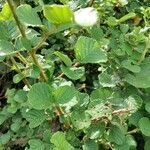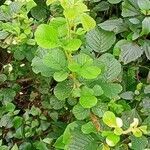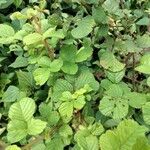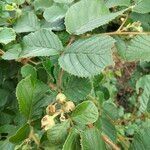Climbing or scrawling shrubs. Stems up to 4 m, densely woolly when young, with many patent red bristles (up to 8 mm long and glandular when young), prickles rather few, straight to slightly curved, up to 8 mm. Leaves 3-foliolate, the upper ones sometimes simple, petiole 1-7.5 cm long. Stipules linear, up to 10 by 0.5 mm, entire, hairy. Leaflets elliptic to orbicular, sometimes slightly ovate or obovate, terminal ones 4-9 by 3.5-9 cm, lateral ones 2-6.5 by 2-6.5 cm, base ± rounded, margin (unequally) serrate, apex from acute to truncate, coriaceous, 7-10 pairs of nerves, patently hairy above, densely woolly and with longer straight hairs on the nerves below. Inflorescences rather lax, up to 30 cm long, with up to 12(-20) much-branched laterals under the terminal flower, the whole inflorescence with up to 150 or more flowers. Bracts linear or 3-partite, hairy. Pedicels up to l(-2) cm long, woolly, with bristles and curved prickles. Hypanthium 4-5 mm across, densely hairy and with bristles outside. Sepals ovate-triangular, 5-7.5 by 3-4.5 mm, entire, shortly acuminate, woolly and with longer hairs and at base also with bristles outside. Petals obovate to spathulate, up to 10 by 5 mm, early falling, rounded or acute, hairy, white. Stamens 30-40, filaments up to 2 mm, anthers c. 0.5 mm long. Pistils 100-150, ovaries on the back with many long straight hairs, especially near apex, on an elevated, densely hairy torus, style up to 2 mm long, hairy at base. Collective fruits ovoid to globose, up to 8 by 10 mm, sepals ultimately slightly spreading. Fruits up to 1.5 by 0.8 mm (dry), exocarp hairy, yellow to orange, mesocarp only a thin layer when dry.
A scrambling shrub. It grows to about 5 m high. The stems and leaf stalks are densely covered with long stiff hairs and armed with rather large spines. The leaves are compound with three leaflets somewhat rounded or elliptical and flattened at the tip. The lower surface is velvety. They are 1.5-9 cm long by 1-7 cm across. The end leaflet is the largest. The flowers are white and borne in clusters. These can be in the axils of leaves or at the ends of branches. The berries are pale yellow, fleshy and fairly good flavour.
Stems covered, especially densely so above, with spreading reddish-brown, bristly, eglandular hairs 2–4 mm. long.. Leaves trifoliolate, the leaflets broadly elliptic and rounded or very obtuse at both ends, up to 5–5.5 × 4 cm., subglabrous and green above, whitish-or yellowish-grey-tomentose beneath, acutely but ± minutely serrated.. Inflorescence shortly cylindrical.. Calyx 5–6 mm. long; lobes ± obtusely ovate, 3–4 mm. long.. Petals yellow, exceeding the sepals.
Leaflets broadly elliptic to obovate, markedly obtuse, sometimes apiculate, the terminal one larger than the laterals; margins minutely serrate; superior surface dark greyish-green, glabrescent; inferior surface pale greenish-grey, very shortly tomentose, with prominent veins, the midrib bristly and prickly.
Flowering branches straight or zig-zag, reddish-brown, somewhat villous, densely covered with stiff, straight, reddish bristles up to 5 mm. long; prickles 3–5 mm. long, straight or weakly decurved, glossy.
Leaves 10–19 x 7–13 cm., temate; petiole and rhachis bristly like the stem, bearing smaller but more strongly hooked prickles; lateral leaflets subsessile, terminal one with petiolule 2·5–4 cm. long.
Inflorescences terminal and axillary, shorter than leaves; peduncles and pedicels villous and bristly, longer than bracts and bracteoles.
Petals white or yellow, c. twice as long as sepals, with broad limb contracting abruptly into narrow claw.
Calyx rather leathery, dorsally bristly near the base, divided into broadly ovate lobes 5–7 mm. long.
Fruit enclosed within persistent calyx, yellow when ripe; carpels subglabrous.
Robust scrambling shrub up to 6 m. tall, with very stout canes.
Stipules stiffly filiform.






